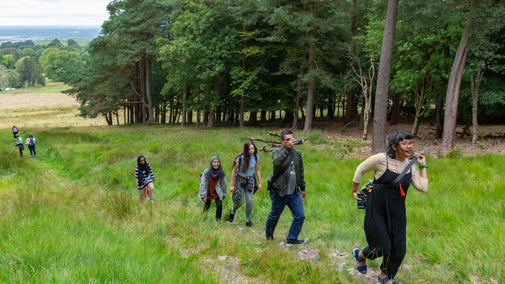Discover Dunsbury trail
Isle of Wight
Take a breezy and invigorating walk over the farmland and downs of the Dunsbury Estate on the Isle of Wight for magnificent coastal views and to learn a bit about the history of the island's coastguard too. We're working to improve the habitat here so that wildlife can flourish so, along the way, keep your eyes peeled for birds such as skylarks and butterflies such as the Glanville fritillary.
Near to
Compton Bay and DownsStart point
Brook Chine car park, PO30 4HA, grid ref: SZ385836Trail information
*Uneven, natural surfaces that can be muddy and slippery in wet weather. For further details, please see Terrain section.
**Uneven surfaces, gates and one stile. For further details, please see section marked Access.
***Dogs welcome under close control. For further details, please see section marked Facilities.
More near here
Compton Bay and Downs walk
A 7.5 mile walk around Compton Bay and Afton Ridge, taking in far-reaching views and the dinosaur fossil beach.

Paradise on the Isle of Wight butterfly walk
This walk passes along the chalk ridge that runs through the middle of the Isle of Wight, one of the best places in the country for spotting rare butterflies, including Adonis blue, small blue, dark-green fritillary and Glanville fritillary.

Get in touch
Our partners

We’ve partnered with Cotswold Outdoor to help everyone make the most of their time outdoors in the places we care for.
You might also be interested in
Compton Bay and Downs Discover Dunsbury trail GPX file
Right-click and 'Save Link As' or ‘Save Target As’ or ‘Download Linked File As’ (depending on your browser) to download this Discover Dunsbury trail GPX file to your device, then open with your GPS program.
Walking
Explore some of the finest landscapes in our care on coastal paths, accessible trails, woodland walks and everything in between. Find the best places to walk near you.

Walking on the Isle of Wight
From discovering dinosaur fossils on a walk at Compton Bay and Downs to the secluded creeks and waterways of Newtown National Nature Reserve, find out where to go for the best walks on the Isle of Wight.

Cotswold Outdoor: our exclusive walking partner
Learn about the National Trust’s ongoing partnership with Cotswold Outdoor. Find out how they help us care for precious places and the exclusive discount available for National Trust supporters.

Follow the Countryside Code
Help to look after National Trust places by observing a few simple guidelines during your visit and following the Countryside Code.

Staying safe at National Trust places
The special places in National Trust care sometimes come with a few risks for visitors, be it coastline or countryside. Find out how to keep safe throughout your visits.

Things to see and do at Compton Bay and Downs
Discover one of the Isle of Wight’s favourite spots with plenty of space to explore, search for fossils, spot local wildlife, surf, cycle and ride your horse.

The Dunsbury project
Discover the Isle of Wight project that aims to return the landscape to wildlife, where people can walk, as well as enjoy butterfly and birdwatching.




